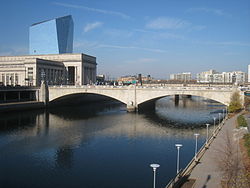- Market Street Bridge (Philadelphia)
-
Market Street Bridge Other name(s) Permanent Bridge
High Street BridgeCarries Pennsylvania Route 3 eastbound Crosses Schuylkill River Locale Philadelphia Designer Timothy Palmer(1805) Design Covered Arch(1805) Material Wood(1805) Total length 1,300 feet (400 m) Piers in water 2 (1805)
1 (1932)Opened 1805 Coordinates 39°57′16″N 75°10′49″W / 39.95444°N 75.18028°WCoordinates: 39°57′16″N 75°10′49″W / 39.95444°N 75.18028°W The existing Market Street Bridge in Philadelphia, Pennsylvania is located where Market Street now crosses the Schuylkill River. The bridge succeeded ferry boats and a couple of rudimentary floating bridges across the Schuylkill River. (While the British were in possession of Philadelphia during the American Revolution, there was a pontoon bridge at this point and later a plank-floor bridge on floating logs.) The Market Street Bridge was also the final link in the Philadelphia and Lancaster Turnpike.
Contents
First bridge
When the directors of the Schuylkill Permanent Bridge Company of Philadelphia elected in 1801 to build a wooden structure across the Schuylkill instead of the stone arch bridge originally planned, they called on Timothy Palmer to complete the job. Palmer (1751–1821) was the best-known wooden bridge builder in the country, and the resulting bridge became his best-known work. Palmer and his workmen completed the structure on two previously-built piers at a cost of US$300,000. Known then as "The Permanent Bridge," it had an overall length of 1,300 feet (400 m), with a center span of 195 feet (59 m) and a 12-foot (3.7 m) rise. The two side spans were 150 feet (46 m) each. Supposedly, this was the first permanent bridge over a major American river, as well as the world's first bridge with regular masonry piers in deep water.
The trusswork was sufficiently completed on January 1, 1805, to permit the bridge to be opened to traffic. But the president of the bridge company asked Palmer if the bridge wouldn't last longer if it was protected from the wind and rain by a weatherproof covering. Palmer said that the bridge's life span might be increased from ten-twelve years to thirty-forty years if a roof and sidewalls were added. Thus was created the first covered bridge in America. It was sometimes referred to as the "High Street Bridge", since Market Street was originally known as "High Street".
Two other bridges
As Palmer had predicted, the bridge stood with little attention until 1850, when a fire gutted it. It was rebuilt and widened for an additional railroad car track, as by then it was also used for railroad traffic. The Market Street Bridge lasted until 1875, when it was completely destroyed by another fire. It was quickly replaced by a wooden structure, which itself was replaced by an iron cantilever bridge completed in 1888.
Existing bridge
The existing Market Street Bridge was erected in 1932, complete with balustrades and other decorative elements. The four eagle statues on the east and west approaches came from New York's Pennsylvania Station, donated to the City of Philadelphia by the Pennsylvania Railroad after Penn Station was demolished in 1963. The Market Street Bridge is across from Philadelphia's 30th Street Station, built and formerly owned by the Pennsylvania Railroad.
See also
List of crossings of the Schuylkill River
References
- Adapted from Shank, William H. (1980). Historic Bridges of Pennsylvania, revised ed.. York, PA: American Canal & Transportation Center. pp. 3–4. ISBN 0933788339. and from other sources.
Crossings of the Schuylkill River Upstream
John F. Kennedy Boulevard Bridge


Market Street Bridge Downstream
Chestnut Street Bridge

 Categories:
Categories:- Bridges in Philadelphia, Pennsylvania
- Bridges completed in 1805
- Bridges completed in 1932
- Schuylkill River
- Road bridges in Pennsylvania
Wikimedia Foundation. 2010.




